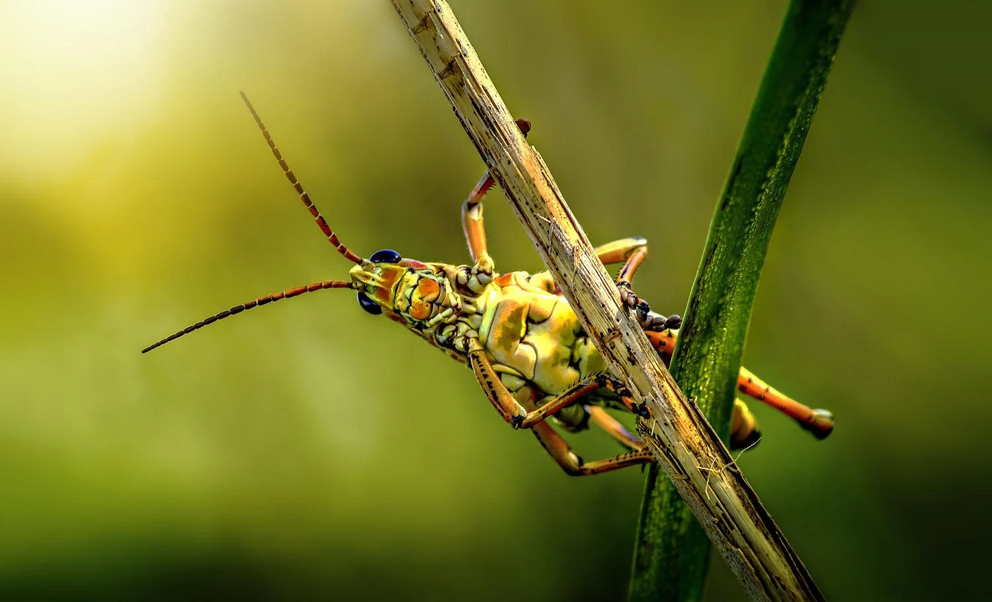Jumpin' Jehoshapat! New grasshopper-like material can leap 200 times its own thickness
Source:
University of Colorado at Boulder
Summary:
If you plop these thin wafers, made up of several layers of a stretchy material called 'liquid crystal elastomers,' onto a hot plate, they will begin to warp. Then, suddenly and explosively, they leap into the air.
FULL STORY
Engineers at the University of Colorado Boulder have designed a new, rubber-like film that can leap high into the air like a grasshopper -- all on its own and without needing outside intervention. Just heat it up and watch it jump!
The researchers describe their achievement Jan. 18 in the journal Science Advances. They say that similar materials could one day help embody "soft robots" (those that don't need gears or other hard components to move) to leap or lift.
The material composite responds a bit like how grasshoppers jump by storing and releasing energy in their legs, said study co-author Timothy White.
"In nature, a lot of adaptations like a grasshopper's leg utilize stored energy, such as an elastic instability," said White, Gallogly Professor of chemical and biological engineering at CU Boulder. "We're trying to create synthetic materials that emulate those natural properties."
The new research takes advantage of the unusual behavior of a class of materials called liquid crystal elastomers. These materials are solid and stretchy polymer versions of the liquid crystals found in laptops or TV displays.
In the study, the team fabricated small wafers of liquid crystal elastomers about the size of a contact lens, then set them on a hot plate. As those films heated up, they began to warp, forming a cone that rose up until, suddenly and explosively, it flipped inside out -- shooting the material up to a height of nearly 200 times its own thickness in just 6 milliseconds.
"This presents opportunities for using polymer materials in new ways for applications like soft robotics where we often need access to these high-speed, high-force actuation mechanisms," said study lead author Tayler Hebner who earned her doctorate degree in chemical and biological engineering at CU Boulder in 2022.
Serendipitous discovery
Hebner, now a postdoctoral researcher at the University of Oregon, and her colleagues discovered this leaping behavior almost by accident.
She was experimenting with designing different kinds of liquid crystal elastomers to see how they changed their shape under shifting temperatures. Joselle McCracken, a senior research associate in White's lab, joined her to observe.
"We were just watching the liquid crystal elastomer sit on the hot plate wondering why it wasn't making the shape we expected. It suddenly jumped right off the testing stage onto the countertop," Hebner said. "We both just looked at each other kind of confused but also excited."
With careful experimentation and help from collaborators at the California Institute of Technology, the team discovered what was making their material do the high jump.
White explained that each of these films are made up of three layers of elastomer. These layers shrink when they get hot, he said, but the top two layers shrink faster than the bottom one. That incongruity, combined with the orientation of the liquid crystal molecules within the layers, causes the film to contract and form a cone shape. It's a bit like how painted vinyl sidings can warp in the sun's rays.
As the cone forms, strain builds up in the film until, all at once -- snap! The cone inverts, slapping the surface and knocking the material up. The same film can also hop several times without wearing out.
"When that inversion happens, the material snaps through, and just like a kid's popper toy, it leaps off the surface," White said.
Leaps forward
Unlike those poppers, however, the team's liquid crystal elastomers are versatile. The researchers can tweak their films so that they hop when they get cold, for example, not hot. They can also give the films legs to make them jump in a particular direction.
Most robots probably wouldn't be able to use this kind of popping effect to make their parts move. But White said that the project shows what similar kinds of materials could be capable of -- storing an impressive amount of elastic energy, then releasing it a single go. And, Hebner said, the project brought a bit of fun to the lab.
"It's a powerful example of how the fundamental concepts we study can transform into designs that perform in complex and amazing ways," she said.
Grasshoppers, meet your new competition.
Video: https://youtu.be/0iggefqpACQ
Journal Reference:
- Tayler S. Hebner, Kevin Korner, Christopher N. Bowman, Kaushik Bhattacharya, Timothy J. White. Leaping liquid crystal elastomers. Science Advances, 2023; 9 (3) DOI: 10.1126/sciadv.ade1320

